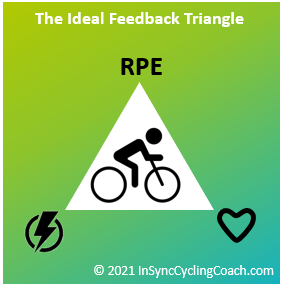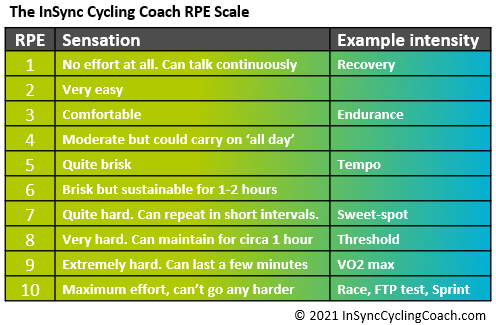What is RPE?
RPE stands for Rating of Perceived Exertion. It is a scale used to record the intensity of a workout based on how hard it felt. There are many different scales, usually ranging from 1 to 10, 10 being a maximal effort.
In this post I’ll discuss the origins of RPE, compare it to the high-tech alternatives and explain why it is still relevant in the data-obsessed world of cycling.
Finally I will cover how I optimise training at inSync Cycling Coach utilising RPE.
History
The original and perhaps most well-known scale was developed by Gunnar Borg of Stockholm University and published in Perceived Exertion and Pain Scales (1998). Borg originally defined 15 levels ranging from 6 to 20 which roughly correlated with the heart rate of a healthy group of middle-aged men and women exercising on a static bike. i.e. level 17 roughly corresponds with a heart rate of 170 beats per minute (bpm). He later created another, simplified 10-point scale for specific medical purposes.
Different ways to record workout intensity
Before portable heart rate monitors and power meters, the only device we had to record the intensity of a workout with was a stopwatch. That is OK in a velodrome where the conditions are very controlled: the intensity required to complete a lap within a certain time is constant from day-to-day (if not rider-to-rider). Outdoors though, a stopwatch isn’t a very accurate way of measuring intensity since cycling speed is as much dependent on the terrain and weather conditions as it is the effort put in by the rider.
To directly quantify a workout’s intensity there are basically three options: power, heart rate and RPE. However before analysing data from any of these methods it is important to understand what they are really measuring:
- Power: Often mistaken for Force, Power is a measure of work done over time measured in Watts, derived from the pedaling force x angular speed. This is the output of a workout.
- Heart rate: Heart rate measures how hard your cardiovascular system is working by recording the rate at which your heart pumps oxygenated blood to the working muscles, in Beats per Minute (bpm).
- Perceived Exertion: RPE measures how hard the effort felt.
Limitations of each method
It is easy to think that since we now have access to heart rate monitors and power meters to measure workout intensity, old-fashioned RPE is redundant. However it is important to understand that all these methods have their shortcomings.
Power meters:
- Whilst costs have fallen, even the cheapest power meter is still many times more expensive than a heart rate monitor. A high-end model costs as much as an entry-level bike.
- If you have multiple bikes then you need multiple power meters, leading to variability issues (discussed below). If you have a pedal-based system you can swap them between bikes but it is time-consuming and brings compatibility issues between pedal systems.
- All power meters measure slightly differently. This is due in part to variability in the manufacturing process but also because they measure power at different parts of the drivetrain. A pedal-based power meter will always record a slightly higher value than a hub-based one due to losses in the drivetrain.
- Most products need regular zero-offsetting (often incorrectly referred to as ‘calibration’). I recommend zero-offsetting before every ride.
- Like any precision measuring device, all power meters should be calibrated annually. How do you know that your 4-year-old power still measures 200W as 200W?
Heart rate
- Using heart rate to measure intensity is ineffective on shorter efforts. This is due to the time it takes for the heart rate to increase and ‘catch-up’ to the intensity. This can take 2-3 minutes so for efforts shorter than that, a HR monitor is no help in gauging intensity.
- Heart rate can be affected by many things apart from workout intensity: temperature, hydration levels, caffeine intake, fatigue, lack of sleep etc.
RPE:
- Obviously RPE is subjective, you don’t get accurate, empirical data or complex graphs to compare across workouts or seasons.
- It takes practice to listen to your body and decide if you are going too hard or too easy.
Why we should (still) record RPE
Recording workout intensity with only power or heart rate means there is no record of how hard the athlete perceived the workout to be. The numbers could be high or low but we have no frame of reference from which to draw a conclusion.
If a rider has power and heart rate data the picture becomes clearer, but now we know the limitations of the data (detailed above) we might draw the wrong conclusion about the athlete.
For example:
- If power was high, were they stronger or just trying harder?
- If heart rate was high, were they fatigued? Or just had one too many espressos beforehand?
- If power was high but heart rate was low, are they getting fitter or was the rider fatigued due to a long block of training?
We can quickly get an answer to these questions by looking at the rider’s RPE.
Of course, as a coach I would like all three metrics in the Ideal Feedback Triangle, as I call it. But actually if there is one metric I can’t live without it is RPE. Knowing how hard a workout felt to an athlete allows me to understand how they are responding to training so I can optimise training prescription and recovery modalities.

How I use Perceived Exertion in my Coaching
Having studied Borg’s scales and many others I have devised my own ranking to make life as simple as possible for my athletes. It is easy to interpret and aligns closely to most scales including the Perceived Exertion used by TrainingPeaks.
It is important to remember that the exact number you use is nowhere near as important as its comparative value. In other words, I might not be concerned about whether an endurance workout was quantified as a 2 or a 4. I am concerned when a workout rated every week as a 3, is suddenly rated as a 5. This could be a sign that, even if the other metrics look OK, the athlete found it considerably harder than normal.

Optimising your training with RPE
Get in touch here to discover how to incorporate RPE into your training feedback for effective results or if you want expert help achieving your goals.
References
Borg, G. (1998) Chapter 5: The Borg RPE Scale. Human Kinetics
Russell Gordon is the owner and cycling coach of inSync Cycling Coach. He helps cyclists of all abilities achieve their goals and he has raced road, time trial and cyclo-cross from regional to national levels. He holds TrainingPeaks Level 1 and British Level 3 cycle coaching accreditations.
